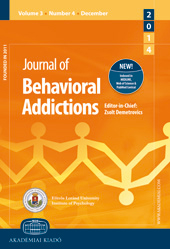Commentary on: Are we overpathologizing everyday life? A tenable blueprint for behavioral addiction research.Can the emerging domain of behavioral addictions bring a new reflection for the field of addictions, by stressing the issue of the context...
Commentary on: Are we overpathologizing everyday life? A tenable blueprint for behavioral addiction research.Can the emerging domain of behavioral addictions bring a new reflection for the field of addictions, by stressing the issue of the context...
Author(s): Philippe De Timary, Pierre PhilippotSubject(s): Cognitive Psychology, Developmental Psychology, Neuropsychology, Behaviorism, Substance abuse and addiction
Published by: Akadémiai Kiadó
Keywords: behavioral addictions; mental health disorders; everyday life;
Summary/Abstract: This paper is a commentary to the article entitled: “Are we overpathologizing everyday life? A tenable blueprint for behavioral addiction research”, by Billieux, Schimmenti, Khazaal, Maurage and Heeren (2015). Methods and Aims: In this manuscript, we commented on two aspects developed by the authors. Billieux et al. (2015) propose that the recent development of propositions of behavioral addiction is driven by an unwise application of an addiction model to excessive behaviors and rests on a confirmatory research strategy that does not question the psychological processes underlying the development of the conduct. They also show that applying a process driven strategy leads to a more appropriate description of the reality of the behavior and conduct, in particular by describing a variety of motivations for the excessive behavior, which is central to understanding the nature of the conduct. We believe that this new approach, which is fruitful to the emerging domain of behavioral addictions, could also apply to the domain of addictions in general. The latter is characterized by the application of a generic biological model, largely influenced by animal models, focusing on neurophysiological determinants of addiction. This approach may have decreased the attention paid to dimensions of addictions that are more specifically human. We will firstly briefly argue on the limitation of this neurophysiological addiction model for the field of excessive behavioral conducts. Secondly, we will argue for an approach centered on the differentiation of motivations and on the adaptive dimension of the behavior when it first developed and on the evocation of a transition where the conduct became independent of its original function. Conclusions: The emerging domain of behavioral addictions, where no animal model has been developed so far, may bring a new reflection that may apply to the domain of addictions in general, with a specific attention to human questions.
Journal: Journal of Behavioral Addictions
- Issue Year: 4/2015
- Issue No: 3
- Page Range: 148-150
- Page Count: 3
- Language: English

